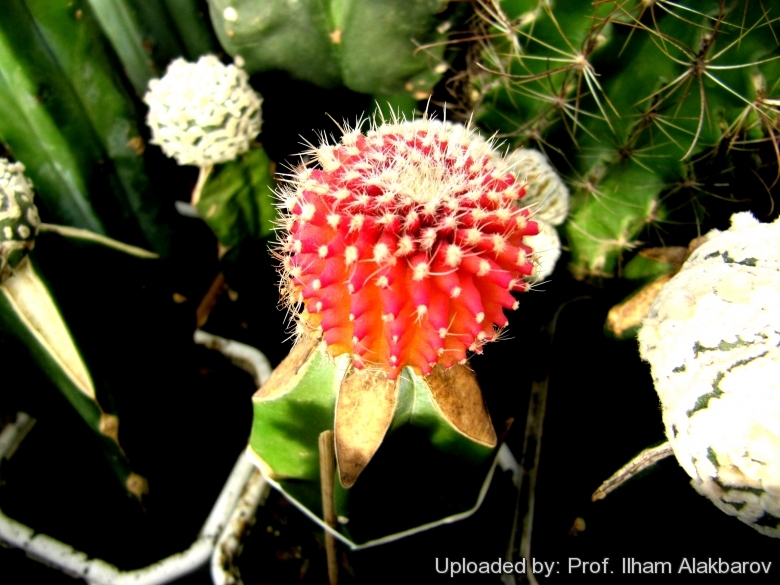Accepted Scientific Name: Uebelmannia gummifera (Backeb. & Voll) Buining
Succulenta (Netherlands) 161, 1967

Uebelmannia gummifera subs. meninensis f. rubra Photo by: Prof. Ilham Alakbarov
Origin and Habitat: Garden origin (Nursery produced cultivar)
Synonyms:
See all synonyms of Uebelmannia gummifera
back
Accepted name in llifle Database:Uebelmannia gummifera (Backeb. & Voll) BuiningSucculenta (Netherlands) 161, 1967Synonymy: 12
back
Description: Uebelmannia gummiferaSN|14305]]SN|14302]] subs. meninensis is a short columnar usually solitary cactus with greyish-green stems with creamy-white wool in the centre, the plants grown in shadow are greener, while the ones in full sun can take a reddish colour.
Forma rubra (red form): The red schizochromic form (Uebelmannia gummiferaSN|14302]]SN|14302]] subs. meninensis f. rubra) has bright orange-red stems due to the absence (or reduced production) of chlorophyll pigments: every other pigment is present at normal levels, the dominant green colouration is lost, but will still more than likely have normal other pigments that give the yellow overall appearance of the stem. This form with red stems is very attractive and highly prized. This schizochromic form is almost always seen grafted on stronger columnar species, and cannot can be grown on its own roots. However some clones have enough chlorophyll in their tissues and can be grown on they own roots too, but very slow growing.
Remarks: Do not confound the red schizochromic 'f. rubra' with the naturally occurring 14302]SN|14305]]|'var. rubra'] which is a redder non schizochromic variety.
Stem: 6-8(-10) cm wide, becoming 10-12 cm high with age.
Ribs: When fully mature it has up to 32 ribs, but initially it has considerably fewer. These ribs at first are strongly tuberculate, later narrow and continuous.
Areoles: Close set, greyish white, at first 3 mm or more apart, then nearly confluent and encompassing the stems.
Central spines: Usually one, straight, gray, pointing slightly upward.
Radial spines: 3 (seldom more), one longer pointing slightly downward, the other lateral more or less erect, subulate, light to dark grey with darker brownish tips, 3-5 mm long.
Flowers: Diurnal sulphur-yellow about 2 cm long, 1,5 cm in diameter.
Blooming season: Flowers come sporadically from early summer to late summer.
Fruit: 1,8 x 6-8 mm yellowish-green and globular with numerous seeds.
Subspecies, varieties, forms and cultivars of plants belonging to the Uebelmannia gummifera group
Cultivation and Propagation: Variegated and albinos cacti are regarded as choice and difficult in cultivation, but despite that many of them are relatively easy to grow. But be aware that they cannot tolerate prolonged exposure to direct sun light (especially during the hottest summer days), so grow them in half-shade or under filtered sun. They are sometime seen as grafted plants, but many grow well on their own roots, too.
On the contrary, the albinos can survive only if grafted on a strong green base.
Use mineral well-permeable substratum with little organic matter (peat, humus). Water sparingly from March till October and keep perfectly dry in winter at temperatures from 10 to 15 degrees centigrade. (In general these plants are more tender and cannot endure freezing temperatures ) In the rest period no high atmospheric humidity!!
Propagation: Usually by seed. Plants are often grafted onto column-shaped cacti.










